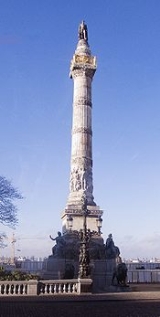
Congress Column
Encyclopedia
The Congress Column is a monument situated on the Place du Congrès / Congresplein in Brussels. It commemorates the formation of the Belgian state and constitution by the National Congress in 1830-1831. It was erected on the initiative of Charles Rogier
after a design by Joseph Poelaert
between 1850 and 1859. It was inspired by Trajan's Column in Rome.
The column, with the statue of king Leopold I of the Belgians surmounting it included, has a total height of 47 meters. A spiral staircase of 193 stairs in the interior of the column leads to a platform surrounding the pedestal of the statue of King Leopold I.
The statue of King Leopold was made by Jean Geefs. The important dates in the struggle for Belgian independence are engraved on the pedestal of the column, together with the names of the members of the National Congress of Belgium
and the Provisional Government
and important passages from the liberal Belgian constitution of 1830. The four sitting statues surrounding the pedestal represent the major constitutional liberties; the 'Liberty of Union' by Charles Fraikin, the Liberty of Worship by Eugène Simonis
, the Liberty of Press and the Liberty of Education both by Jean Geefs. Two monumental bronze Lions by Eugène Simonis
are placed in front of the monument.
As a memorial to the Belgian victims of the First World War, five anonymous soldiers were buried at the foot of the monument, the 11th of November 1922. Their tomb is surmounted by an eternal flame.
Charles Rogier
Charles Latour Rogier was a Belgian liberal statesman and a leader in the Belgian Revolution of 1830. He became Prime Minister of Belgium on two separate occasions: from 1847 to 1852, and again from 1857 to 1868....
after a design by Joseph Poelaert
Joseph Poelaert
Joseph Poelaert was a Belgian architect.- Life :Born in Brussels to Philip Poelaert , a former architecture student at the Académie Royale des Beaux-Arts in Brussels, Poelaert also trained there under Tilman-François Suys, and then in Paris under Louis Visconti and Jean-Nicolas Huyot.Poelaert...
between 1850 and 1859. It was inspired by Trajan's Column in Rome.
The column, with the statue of king Leopold I of the Belgians surmounting it included, has a total height of 47 meters. A spiral staircase of 193 stairs in the interior of the column leads to a platform surrounding the pedestal of the statue of King Leopold I.
The statue of King Leopold was made by Jean Geefs. The important dates in the struggle for Belgian independence are engraved on the pedestal of the column, together with the names of the members of the National Congress of Belgium
National Congress of Belgium
The Belgian National Congress was a temporary legislative assembly in 1830, established shortly after the Provisional Government of Belgium had proclaimed Belgian independence on October 4 of that year...
and the Provisional Government
Provisional Government of Belgium
The Provisional Government was formed as a revolutionary committee of notables during the Belgian Revolution on September 24, 1830 at the Brussels City Hall under the name of Administrative Commission....
and important passages from the liberal Belgian constitution of 1830. The four sitting statues surrounding the pedestal represent the major constitutional liberties; the 'Liberty of Union' by Charles Fraikin, the Liberty of Worship by Eugène Simonis
Eugène Simonis
Louis-Eugène Simonis was a Belgian sculptor.-Career:Simonis studied under François-Joseph Dewandre at the Academie Royale des Beaux-Arts in Liège and at the age of nineteen went to Italy, where he continued his studies in Bologna and Rome. When he returned to Belgium he accepted an instructor...
, the Liberty of Press and the Liberty of Education both by Jean Geefs. Two monumental bronze Lions by Eugène Simonis
Eugène Simonis
Louis-Eugène Simonis was a Belgian sculptor.-Career:Simonis studied under François-Joseph Dewandre at the Academie Royale des Beaux-Arts in Liège and at the age of nineteen went to Italy, where he continued his studies in Bologna and Rome. When he returned to Belgium he accepted an instructor...
are placed in front of the monument.
As a memorial to the Belgian victims of the First World War, five anonymous soldiers were buried at the foot of the monument, the 11th of November 1922. Their tomb is surmounted by an eternal flame.

